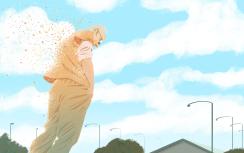
Illustrations by Michael Marsicano
On a sunny afternoon in May, about a dozen inmates at Otisville prison camp played handball. Adjacent to the court was a low-slung, drably painted housing unit. No perimeter fence or barbed wire surrounded the grounds, located roughly two miles up a winding road through dense, rocky forest. Canada geese waddled nearby as the inmates — clad in regulation shorts and T-shirts and shaved heads — worked up a sweat.
But for a lone guard, it would have been easy to overlook the fact that the players happened to be prisoners.
For federal inmates, this is about as good as it gets. The Federal Correctional Institution in Otisville, roughly 80 miles north of New York City, is one of several dozen minimum-security prisons — typically called camps — in the federal Bureau of Prisons system, where many white-collar convicts end up serving out their sentences. Unlike the low-, medium-, and high-security institutions where most inmates do time, camps are not fenced in. The doors aren’t even locked.
But criminal justice experts and former inmates say federal prison camps, while better than most prisons, are still no walk in the park — and forget about “Club Fed,” the nickname given to some minimum-security prisons in the ‘80s. These days, experts say, hard time is just that.
“There is no Club Fed — that’s so much B.S.,” says Michael Frantz, a former federal inmate of nearly three years for tax evasion and Medicare fraud. He’s since founded Jail Time Consulting, which helps future inmates prepare for prison life.
“Just the term ‘camp’ makes it sound kind of fun,” says Michael Kimelman, who served 15 months in Lewisburg, Pennsylvania, on insider trading charges and wrote a book about his experience, Confessions of a Wall Street Insider. “In The Wolf of Wall Street, he’s playing tennis at the end. In the ‘80s I think there were a couple of places like that. There’s no place now that anybody semi-normal would ever want to go, period.”
Kimelman was one of several former Wall Street traders caught in then-U.S. Attorney Preet Bharara’s vast insider trading sting, which landed in prison highfliers like Galleon Group founder Raj Rajaratnam, FrontPoint Partners portfolio manager Joseph (Chip) Skowron, and former SAC Capital Advisors portfolio manager Mathew Martoma. Several others, whose crimes didn’t come near those cases in scale and intensity, landed there too. (This story was originally published in May. Since then, Michael Cohen, a former attorney for President Donald Trump, was sentenced to three years in prison for illegally making payments to silence two women who alleged they had affairs with Trump. A judge said he would recommend that Cohen serve his sentence at Otisville.)
In the past few years, several people convicted of insider trading and sentenced to prison as part of that probe have reentered society and started trying to rebuild their lives. They’re finding that their punishment doesn’t end when their sentences are over. Many have several years of supervised release, with restrictions that prevent travel. They can be stripped of their degrees, may be permanently barred from the industry, and have a criminal record. Serving even a short stint can make it all but impossible for ambitious former Wall Streeters to ever work in finance again. And that’s to say nothing of the Google trail.
“It is a life sentence,” Kimelman says over iced teas in Larchmont, the upmarket New York City suburb where he lived with his now ex-wife and three children before the insider trading conviction. (He refused to take a plea deal and maintains his innocence.)
“I don’t think judges, prosecutors, or even defense lawyers really understand what happens once the gavel comes down at the end of the trial. Right now we’re pretending that you learn a lesson, you rehabilitate, you go on and live a life — but with the exception of New York and some other, more forward-looking states, we’ve done everything we can in the last 20 years to make sure that you keep paying that price over and over and over again.” For example, his record comes up when he fills out school applications for his kids or if he wants to coach their Little League teams.
Kimelman, along with other former inmates interviewed for this story, readily acknowledges that they have it easy relative to most ex-cons. The majority of inmates couldn’t afford to hire top defense lawyers to keep them out and, failing that, pricey prison consultants to shorten and ease their time inside.
There are approximately 184,000 inmates in the Bureau of Prisons system, of which some 7 percent are incarcerated for white-collar crimes, according to BOP inmate data. The BOP operates federal prisons, which house inmates who committed federal crimes, such as wire and securities fraud. Many of these and other nonviolent inmates are sentenced to camps. Where an inmate serves depends on the length of their sentence and proximity to their home; the BOP attempts to send inmates to prisons within 500 miles of their homes. (Bernie Madoff landed in medium security due to the length of his sentence — 150 years.)
Criminal justice experts say the Club Fed sobriquet gained traction after a 60 Minutes segment that aired in 1987, showing inmates playing tennis on lush, manicured lawns — conditions some saw as too cushy for white-collar criminals. “That’s when things changed,” says Larry Levine, founder of Wall Street Prison Consultants, who served ten years in 11 facilities for drug trafficking, racketeering, and securities fraud charges, among others. “Society was outraged — look at what these inmates have.”
A Bureau of Prisons spokesperson said in an email that all sports courts at BOP facilities are multipurpose, and that swimming pools — which used to exist at some facilities — have since been filled in. But the Club Fed myth endures. A 2012 New York Post article on Otisville’s prison camp described it as a “walled Shangri-La” of bocce courts and horseshoe pits, with a commissary selling rib steak, salmon, and smoked oysters. (The lawn games part is true, according to the BOP spokesperson.)
Such amenities wouldn’t cancel out what former inmates say are the worst aspects of prison camp life: the casual sadism of some prison staff, unsavory food, separation from their families — and relentless, crushing boredom.
“Some think camp is a breeze,” says prison consultant Frantz. “You’re not out on a rock pile, slinging a hammer on stones, but it’s just terribly boring. There’s nothing to do. The first three months I was lost. I’d look at my watch and it was 9:00 in the morning. I’d look at it eight hours later and it was 9:05 in the morning.”
For white-collar inmates accustomed to being in charge, prison life is a harsh awakening — from the moment they walk through the doors.
Many are allowed to self-surrender, meaning that sometime after sentencing they will receive a letter from the Bureau of Prisons telling them where and when to report for punishment. The BOP issues a handbook to tell people what to expect, but inmates say there is no true way to prepare.
“The intake process is shocking. Until you actually go through it, you can’t really anticipate it or believe it,” says Kimelman. “It’s sort of what you see in the movies, sort of not. There’s a lot of the strip-down and the searching.”
Once inmates are strip-searched, they are swabbed for DNA, fingerprinted, asked security questions, and given a health check and then a psychological evaluation. Once that process is complete, they are assigned their bunk. “The guard said, ‘I’m going to put you with a couple of drug-dealing N-words; I’ll put you in with your own kind in a little bit,’” Kimelman remembers — his first brush with racism on the inside. Then comes the prison uniform. The camp didn’t have his size, so Kimelman’s standard-issue khakis and white T-shirt were several sizes too big. He was then told to go straight to lunch.
“I walked into the lunch hall knowing no one, wearing a clown outfit, and it’s literally like that record scratch,” he says.
Jeff Grant had a similar experience. Once a powerful lawyer in Mamaroneck — another wealthy New York City suburb — Grant had spiraled into opiate addiction when he made the decisions that landed him in prison. He dipped into his firm’s escrow accounts to pay for personal expenses and fraudulently asserted on an application for a disaster-relief loan that the terror attacks of September 11, 2001, had hurt his law firm. Then he got caught.
“It’s like if you got on an airplane and landed in Mongolia, and you don’t speak the language, you don’t know the culture, you have no money in your pocket, and somehow you have to still navigate your way from the airport to wherever you gotta go,” says Grant, who attempted suicide in 2002 after the charges, got sober not long after, and joined a prayer group. He served 13 months in low-security lockup and now leads Family ReEntry, a criminal justice nonprofit that provides intervention and support programs for former inmates. “It’s exactly the same thing.”
It takes a few weeks to get into the rhythms of prison life, ex-cons say. For most inmates a typical day goes something like this: At 6:00 a.m. the lights come on in the dormitory and a voice over the loudspeakers declares, “The compound is now open.” This sparks a mad dash for the bathroom and cafeteria — inmates are given 90 minutes to take care of their business, make up their bunk beds (with hospital corners), and tidy up their living quarters before reporting to work call at 7:30 a.m.
Inmates work jobs for 12 to 40 cents an hour, including janitorial duty, kitchen work, clerical work, and even tutoring fellow inmates for their GED tests. After roughly three hours they break for lunch; then it’s back to work at around noon. Unlike at prisons with higher levels of security, minimum-security inmates can move around freely. Around 3:30 p.m. they turn in their tools and report back to their bunks for a headcount, followed by dinner beginning around 4:00 p.m. Then they have several open hours before the final count of the day at 10:00 p.m. In their free time inmates can take classes, go to the library, watch TV (there are usually three or four, with one designated for sports, one for Spanish-language programming, and so on), play cards or sports, or attend religious services. Then, the next day, they get up and do it all over again, every day until their sentence is completed.
“It’s like Groundhog Day,” says Levine, using an analogy others echoed. “The only thing that changes is the characters.”
But in his view it’s not all bad. “Prison is what you make it,” Levine says. “A lot of people spend their time watching TV, jerking off, playing cards — I spent my time in the law library,” which is where he learned enough about the prison system to start a successful prison consulting business after his release. “In these institutions you need to program your time. I advise my clients to use their time wisely. You’ve got an opportunity when you’re in custody that other people really don’t have. Other than doing your stupid little job, being there for count time, respecting others, what responsibilities do you have? Nothing. You can actually have a pretty good time.”
There are obvious downsides — foremost, isolation from family. Inmates are given only 300 minutes of phone time per month. They are allowed to use email, but it costs 5 cents per minute, and they can’t download attachments or access the wider internet.
“Inmates are encouraged to stay closer to their families, [because] they are less likely to reoffend. But the phone calls are very expensive,” says attorney and criminal sentencing expert Alan Ellis. Visitation hours are limited and can be rescinded at a whim. Once, Grant’s wife was turned away for wearing capris, which were deemed to be “short pants” — and verboten for visitors. Kimelman says if one prisoner got caught smoking, visitation privileges could be revoked for his whole unit.
And then there’s the food.
On paper, the Bureau of Prisons lunch menu doesn’t look so bad: roast beef, taco salad, oven-brown potatoes. But some say the reality is different. “We had food coming in that was outdated four, five years,” says Frantz. “For the four years I was in there, I didn’t know chickens had breast. Lettuce, what’s that? Produce?”
Cafeteria options appeared to be roughly 85 percent white carbs, Kimelman estimates. “Then they’ll add some things you didn’t realize existed, like pork in a cup. You would get a shot cup of pork gristle. You would get that, you would get beans. Anything they can cook in a humongous vat. You’d have one decent meal a week, which was chicken on the bone, which is an actual piece of chicken,” Kimelman says. “People practically fought for that.”
Meals have improved over the last few years, says former warden and camp administrator Maureen Baird, thanks to a national menu and licensed nutritionists. “I had the food every day, the same food that the inmates ate, and staff paid $2.25 for a meal ticket,” she says. “I thought the food was pretty good.”
Those who have the means can cobble together a half-decent diet at the commissary, which sells oatmeal, peanut butter, spaghetti sauce, and foil pouches of tuna and mackerel. The mackerel, oddly, has become something of a currency in the prison system, where packets, called “macs,” are used to pay other inmates for services like shoe shines and haircuts.
Commissary items can be heated in the microwave — the only cooking apparatus inmates have access to. Some get creative. Kimelman says he saw cheesecake fashioned in the microwave out of coffee creamer. Grant remembers eating mush when an inmate on kitchen detail slapped a filled-up rubber glove on the tray next to him. The inmate cut open the glove to reveal a cooked steak. (The cost for such personalized cuisine? Two macs.)
Commissary prices can humble former big spenders. When you only earn 40 cents an hour, $5 seems exorbitant for a bottle of shampoo. Holli Coulman — a paralegal and women’s prison consultant who works with Levine and who served 13 months for wire fraud — says tampons, which used to be provided to female inmates for free, must now be purchased from the commissary at a cost of $4.15 per box. Inmates can spend up to $300 per month in the commissary.
Grant was supposed to serve at a minimum-security facility but instead got assigned to Allenwood, which had closed its camp. He served in the low-security prison, the lowest available there. He says he witnessed two murders.
In one instance, during a game of flag football, two inmates were arguing, when one suddenly grabbed the other by his dreadlocks, which were tied on top of his head like a bun. He beat the man’s head against the sidewalk until he died.
In the other instance, one man walked up behind another man, grabbed his head, and jammed a pen through his ear. “And I was watching it,” Grant says solemnly. “It was just terrible.” (Institutional Investor could not independently confirm these events, and the BOP did not respond to a request for comment about these specific instances.)
Sometimes the violence is perpetrated by BOP staff, former inmates say. Kimelman tells the story of how one inmate began caring for a kitten that had wandered up onto the compound (since it was an open campus). The inmate created a bed for the animal and would bring it milk from the cafeteria. “A guard saw it and killed it — literally stepped on its head and crushed it,” he says, recoiling at the memory.
Stories about racism, misogyny, and harsh punishments for minor infractions abound. One officer told Kimelman, who is Jewish, “We have gas in the showers for you Jews.”
Coulman, when faced with sexual harassment, tried to fight back — to no avail, she says. “I was sexually harassed on a daily basis — ‘Sugar tits, get over here’ — and there were girls who would [perform sexual favors] because they could use the phone. Every time I tried to write it up the prison way” — via a form called a “cop-out”— “they were just shredded.”
Inmates say they quickly learned to toe the line. To argue or show defiance could land you in the special housing unit, or SHU, also known as the hole.
“They don’t make a lot of money,” Frantz says of the guards, who make roughly $50,000 per year, on average. “But the thing they have is the power of life and death of the inmates. You have the president of [a corporation] and you can tell him to go to hell. You can tell him to get on his hands and knees and scrub the floor with a toothbrush.”
Coulman says this power balance sometimes works against white-collar inmates. “If you’re white collar, it’s worse. Because they think we stole from them,” she says. “And they felt we lived better than them and that we should be punished. They were asking me to get on my knees and clean the baseboards.”
In an emailed statement, a BOP spokesperson said, “The bureau takes allegations of staff misconduct seriously; allegations are thoroughly investigated and, based on the findings, appropriate action is taken.”
While she could not comment on these specific incidents, since she never worked at these particular facilities, Baird, the former BOP warden, says she finds such incidents unacceptable, but acknowledges that such behavior is not unheard of. “I’m not going to say it’s completely unusual,” she says, but adds that she worked with far more good guards than bad ones, and she notes that guards at higher-level security facilities can be subjected to violence themselves.
But she urges inmates who witness or are subjected to harassment or violence to report it — and to write directly to the U.S. Justice Department’s Office of the Inspector General if their cop-out filing is ignored. She acknowledges that inmates may be afraid to do so while they are incarcerated, but says they can do so after they leave. And she takes pains to point out that she and others she worked with in the BOP strove to treat inmates with dignity. “I was firm, and I was tough with them when they broke the rules, but I was also kind and respectful and all about preserving their dignity as much as I possibly could,” she says. “Their dignity is already taken from them in so many different ways; I wasn’t going to make things worse.”
This squares with former prisoners’ views. “Some guards were terrible; some guards were great,” says Grant. “And there was everyone in between.”
“If you’re respectful and you understand the rules, and you’re somebody who treats others with respect, you’ll be fine,” says Kimelman. “If you’re a guy who thinks he’s better than people, that’s pretty obvious and that shows up really quickly. There are people who have nothing in their lives who end up in prison, and there are people who have everything in their lives and end up in prison, and for the first time in their life they’re equal.”
This can be especially hard for white-collar inmates who arrive with their Wall Street egos intact. Grant says he has to explain to his clients that the strengths that made them successful in business, including boldness and a willingness to take risks, “are the opposite of things you need to be successful in prison.”

“The stigma’s huge and there are no jobs,” says Grant. “They’re stopped from going back to their old careers because of licensing issues. If you’re in finance, you can’t go back. Law, can’t go back. I know guys who are driving Uber, working in construction. Imagine that you live two lives — one life as a hedge fund manager and another life as a janitor. You don’t really care about living two lives, you only care about the order. I’ve never met one janitor who minded becoming a hedge fund manager.”
Of course, some would argue that at least some former inmates deserve to live with those consequences. After all, while some maintain their innocence, others freely admit that they embezzled, stole, cheated, cost retirees their savings or colleagues their jobs, and ripped apart their own families.
Andy Fastow, the former chief financial officer of Enron Corp. and architect of the accounting fraud that took down the company in 2001, for example, caused thousands of people to lose their jobs and, for many, their retirement savings. He was sentenced to six years. Fastow is out now, hitting the lecture circuit and teaching business and law ethics classes, talking frankly about his crimes and how and why he perpetrated them. He declined multiple requests to be interviewed for this story, however.
Then there’s FrontPoint’s Skowron, a surgeon turned hedge fund wunderkind who was co-managing a big health-care portfolio and driving an Aston Martin around New Canaan, Connecticut, before he was busted by the feds for bribing a doctor to give him the results of clinical trials — actions helped FrontPoint avoid $30 million in losses but cost Skowron five years in prison. Institutional investors immediately withdrew billions from FrontPoint, causing it to shut down. In a filmed discussion hosted by a Christian men’s club, Skowron — whose life before the crime was marked by harrowing experiences including a teenage addiction to crack and the death of his mother in a car accident — speaks bluntly about his culpability.
“When I was 40 years old, I was looking out of the window of my office. I had eight cars in the garage, I had four beautiful children,” Skowron says in the video. “I had a terribly corrupt life. There wasn’t any line I wouldn’t cross . . . . Over 200 people lost their jobs because of me. My wife and my children endured extraordinary embarrassment, isolation, and absence because of my choices because of the empire I thought I needed to build.”
Skowron, who declined to comment for this story, got out of prison in 2017. As he and others like him are being released, they are starting to talk more openly about their experiences in prison — partly as a coping mechanism, it seems, and for some, as a way to make money, since they can’t work in their previous fields. Some hope their experience can help others coming out of the system.
“That’s one of the reasons we started our white-collar support group, to create a community of people with these problems from all over the country but [who] were living in isolation,” says Grant.
They are also talking about their experiences to shine a bright light on what they see as the failings of the criminal justice system. Kimelman thinks society isn’t better off for keeping people convicted of insider trading in prison for years. “You already took career, job, reputation, degrees, and everything else. Now when I try to go for an interview or apply to a school, or get housing, or do anything, that’s still front and center and it’s the first thing that comes up. I couldn’t open up a bank account until recently. If we want to say that any crime becomes a life sentence, then let’s say that. That’s not what we’re pretending to do here.”
And those problems are far worse, Kimelman and others say, for former inmates of limited or no means who are trying to rebuild their lives on the outside. “I struggled. Now think about the kid dropped off at 152nd in the Bronx with the $38 they give you. What’s that guy going to do?” asks Kimelman.
“One of the great failings of our society is that we don’t provide a supportive community for people who are coming back from prison, so people flounder,” Grant says.
With rates of incarceration reaching record levels, the problem is becoming systemic, according to the Equal Justice Initiative, a Montgomery, Alabama-based advocacy group. There are more than 2.2 million people in prison, with another 5 million under some type of community-based supervision, such as parole, the EJI says.
Getting a job is crucial to reentering society, but when job applicants have to disclose on job applications that they have a criminal record, the chance of getting an interview falls by 50 percent, the EJI reports. Former inmates face high hurdles when it comes to employment, housing, and getting professional licenses back; in many states, former inmates can’t even vote.
In any case, investigators will continue to prosecute white-collar crimes. And for those who are convicted, Kimelman offers a piece of advice — one he didn’t take.
“Take the plea,” he says. “Plea as quick as possible and try to get sentenced as quick as possible and go on with your life. That’s the hard part.”
Read More: Better Call Larry





